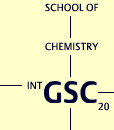 |


![]()
Name: Chun Kong Mak
Diploma / M.Sc degree: Hong Kong Baptist University, Hong Kong
(August 2011)
PhD Project: Simulation of Reactions of Thyroxine (T4) by Electrochemistry-Liquid Chromatography-Mass Spectrometry (EC/LC/MS) and Quantification of Thyroxine (T4) and Triiodothyronine (T3) by Iodine Speciation with Liquid Chromatography-Inductively Coupled Plasma-Mass Spectrometry (LC/ICP-MS)
Abstract of Research Project
Thyroxine (T4) and triidothyronine (T3) are hormones produced by the thyroid gland. They play an important role to control cellular metabolism, body temperature, reproduction and growth. T4 and T3 consist of 65% and 59% iodine by mass, respectively. Appropriate amount of iodine intake, depending on physiological state and age, is essential for the purpose of T4 and T3 synthesis in human body. Iodine deficiency can result into disorders such as hypothyroidism or thyroid gland diseases (goiter), cretinism, irreversible mental retardation, increased perinatal mortality, and development of anomalies. When the iodine intake is in excess, autoimmune diseases and hyperthyroidism will be resulted. Simulation of the biological reactions of T4 may give us further information about hormone production mechanisms in the thyroid gland by purely instrumental EC/LC/MS analysis instead of tedious in-vitro and invasive in-vivo tests. On the other hand, an analytical method with a lower limit of detection (LOD) should be developed for quantification of T3 and T4 in biological matrices such as urine and blood, so that clinical samples from patients can be analyzed, which helps clinical staff to determine if patients’ T3 and T4 levels are appropriate.
All T4 in our body is produced from thyroid gland. Most T3 is derived from 5’-deiodination of T4 by deiodinase enzymes in non-thyroidal tissues such as the liver and kidneys. T3 is an active form of the hormone, while inactive metabolites such as rT3 or T2 can be produced by 5-deiodination. In this project, an electrochemical cell will be used to oxidize T4, which might possibly simulate the biological mechanism. Oxidized products will be separated with online-coupled LC and then characterized by MS.
According to literature [1-2], the secretary molar ratio of T4 to T3 was found to be around 14:1 in humans. Method development for quantification of T3 and T4 with a lower LOD will be attempted with LC/ICP-MS. Quantification of the oxidized products will be done by EC/LC/ICP-MS. The ratio of T3 to T4 in the oxidized products may be used as evidence to check if the simulation can mimic the biological mechanism.
References:
[1] Adams, R. D.; Rosman, N. P. Hypothyroidism: neuromuscular system, S.C. Werner, S.H. Ingbar, Editors , The thyroid, Academic Press, New York (1971), 901–910.
[2] Ingbar, S. H. The influence of aging on the human thyroid hormone economy, R.B. Greenblatt, Editor, Geriatric endocrinology, Raven Press, New York (1978), 13–31.